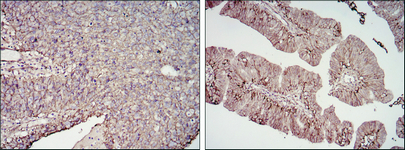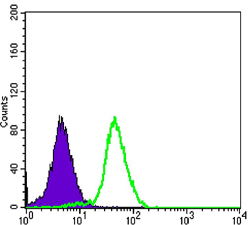CD276 Monoclonal Antibody
- Catalog No.:YM0115
- Applications:WB;IHC;IF;FCM;ELISA
- Reactivity:Human
- Target:
- CD276
- Fields:
- >>Cell adhesion molecules
- Gene Name:
- CD276
- Protein Name:
- CD276 antigen
- Human Gene Id:
- 80381
- Human Swiss Prot No:
- Q5ZPR3
- Mouse Swiss Prot No:
- Q8VE98
- Immunogen:
- Purified recombinant fragment of human CD276 expressed in E. Coli.
- Specificity:
- CD276 Monoclonal Antibody detects endogenous levels of CD276 protein.
- Formulation:
- Liquid in PBS containing 50% glycerol, 0.5% BSA and 0.02% sodium azide.
- Source:
- Monoclonal, Mouse
- Dilution:
- WB 1:500 - 1:2000. IHC 1:200 - 1:1000. Flow cytometry: 1:200 - 1:400. ELISA: 1:10000.. IF 1:50-200
- Purification:
- Affinity purification
- Storage Stability:
- -15°C to -25°C/1 year(Do not lower than -25°C)
- Other Name:
- CD276;B7H3;PSEC0249;CD276 antigen;4Ig-B7-H3;B7 homolog 3;B7-H3;Costimulatory molecule;CD antigen CD276
- Observed Band(KD):
- 100kd
- References:
- 1. Genome Res. 2004 Oct;14(10B):2121-7.
2. Cell Mol Immunol. 2005 Aug;2(4):307-11.
- Background:
- The protein encoded by this gene belongs to the immunoglobulin superfamily, and thought to participate in the regulation of T-cell-mediated immune response. Studies show that while the transcript of this gene is ubiquitously expressed in normal tissues and solid tumors, the protein is preferentially expressed only in tumor tissues. Additionally, it was observed that the 3' UTR of this transcript contains a target site for miR29 microRNA, and there is an inverse correlation between the expression of this protein and miR29 levels, suggesting regulation of expression of this gene product by miR29. Alternatively spliced transcript variants encoding different isoforms have been found for this gene. [provided by RefSeq, Sep 2011],
- Function:
- function:May participate in the regulation of T-cell-mediated immune response. May play a protective role in tumor cells by inhibiting natural-killer mediated cell lysis as well as a role of marker for detection of neuroblastoma cells. May be involved in the development of acute and chronic transplant rejection and in the regulation of lymphocytic activity at mucosal surfaces. Could also play a key role in providing the placenta and fetus with a suitable immunological environment throughout pregnancy. Both isoform 1 and isoform 2 appear to be redundant in their ability to modulate CD4 T-cell responses. Isoform 2 is shown to enhance the induction of cytotoxic T-cells and selectively stimulates interferon gamma production in the presence of T-cell receptor signaling.,induction:By LPS in monocytes and by ionomycin in T and B lymphocytes. Up-regulated in cells mediating rejection of human tr
- Subcellular Location:
- Membrane ; Single-pass type I membrane protein .
- Expression:
- Ubiquitous but not detectable in peripheral blood lymphocytes or granulocytes. Weakly expressed in resting monocytes. Expressed in dendritic cells derived from monocytes. Expressed in epithelial cells of sinonasal tissue. Expressed in extravillous trophoblast cells and Hofbauer cells of the first trimester placenta and term placenta.
- June 19-2018
- WESTERN IMMUNOBLOTTING PROTOCOL
- June 19-2018
- IMMUNOHISTOCHEMISTRY-PARAFFIN PROTOCOL
- June 19-2018
- IMMUNOFLUORESCENCE PROTOCOL
- September 08-2020
- FLOW-CYTOMEYRT-PROTOCOL
- May 20-2022
- Cell-Based ELISA│解您多样本WB检测之困扰
- July 13-2018
- CELL-BASED-ELISA-PROTOCOL-FOR-ACETYL-PROTEIN
- July 13-2018
- CELL-BASED-ELISA-PROTOCOL-FOR-PHOSPHO-PROTEIN
- July 13-2018
- Antibody-FAQs
- Products Images

- Western Blot analysis using CD276 Monoclonal Antibody against HEK293 (1) and CD276-hIgGFc transfected HEK293 (2) cell lysate.

- Immunohistochemistry analysis of paraffin-embedded cervical cancer tissues (left) and ovarian cancer tissues (right) with DAB staining using CD276 Monoclonal Antibody.

- Flow cytometric analysis of PC-3 cells using CD276 Monoclonal Antibody (green) and negative control (purple).



